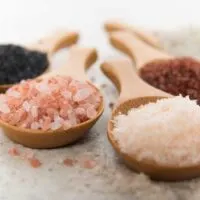The flavor journey of our food involves various elements, and one quintessential ingredient that enriches this journey is salt. However, the taste adventure doesn’t stop there. Salt isn’t merely a taste-bud tickler, but a labyrinth of options, including pink Himalayan salt, sea salt, Celtic salt, and commonly used table salt. Each variant offers unique elements that contribute to their composition, sourcing, and health benefits.
This article aims to dismantle the salt matrix, diving deep into the fascinating realm of salt varieties. We’ll explore their unique attributes and the potential health impacts they may entail.
What is Salt?
In essence, edible salt, or sodium chloride, has been an integral part of human civilization for centuries, playing pivotal roles in preservation and seasoning. Its contribution to food preservation revolutionized the transportation of food, facilitating the development of civilization.
The production methods for this essential compound can vary depending on its source, such as sea, mine, or lake, which in turn influence its flavor, size, and texture.
Sodium Chloride and Sodium Levels
While all salt variants primarily consist of sodium chloride, different crystal structures and mineral content may affect how the body processes and utilizes sodium. Types such as pink Himalayan salt, sea salt, and Celtic salt can have slightly lower sodium levels compared to table salt, leading to less concentrated sodium intake. This could be advantageous for individuals needing to monitor their sodium consumption, but remember, moderation is key to maintaining a balanced diet, irrespective of the salt type.
Now, let’s unravel the myriad types of salts and their distinctive qualities:
Diverse Salt Types and Their Unique Characteristics

- Table Salt: Often what comes to mind when we say “salt.” It has fine grains, derived either from mining or evaporation. Due to further processing, it loses trace minerals and gains additives like potassium iodide and caking agents, making it the least healthiest option.
- Kosher Salt: Known for its coarse texture, larger crystals, and lack of additives, kosher salt has traditionally been used in the koshering process. It’s easy-dissolving nature and unique texture have made it popular in the culinary world.
- Sea Salt: Produced by evaporating seawater, the mineral content and evaporation methods of sea salt can vary depending on the production area. To retain the highest mineral content, consider purchasing high-quality sea salt, like that offered by Ava Jane’s Kitchen.

- Lake Salt: Derived from salt lakes, it is nearly pure and free from heavy metals or chemical impurities. The most notable salt lakes include the Great Salt Lake in Utah, United States, and one in Central Anatolia, Turkey.
- Pink Salt: Predominantly known as Himalayan pink salt, it has a distinctive pink hue due to the presence of natural trace minerals, like potassium, magnesium, and calcium. These minerals can help regulate bodily functions and maintain electrolyte balance.
- Gray Salt (Sel Gris): Hand-harvested from clay-lined pools in France, gray salt is infused with minerals from the clay, like calcium, manganese, and iron, giving it a gray color and a soft, flaky texture.
- Fleur de sel Salt Flakes: An expensive and rare type, Fleur de sel, harvested from the surface of saltwater ponds in Brittany, France, has a briny flavor, less sodium, and more minerals compared to table salt.
- Himalayan Black Salt: Despite its name, it is purple/red in color, originating from the mineral greigite.
- Hawaiian Black Lava Salt: This salt is derived from the evaporation of pools on hardened lava flows. After the harvest, it’s mixed with activated coconut charcoal, giving it a unique flavor profile.
- Hawaiian Red Salt (Alaea Salt): This unique salt gets its brick red color from the red volcanic clay ‘alaea’ that’s mixed with the harvested unrefined sea salt. It’s packed with around 80 natural elements, electrolytes, and trace minerals, such as potassium and magnesium.
- Pickling Salt: Used predominantly for pickling, this salt type is coarse, iodine-free, and contains no anti-caking ingredients. Its fine granules dissolve easily in brine, making it ideal for pickling.

- Celtic Grey Sea Salt: Harvested from the tidal ponds off the coast of France, Celtic salt gets its grey color from the minerals left after the seawater evaporates. It’s packed with balanced amounts of 82 minerals, including magnesium, which aids water absorption in cells.
- Cyprus Black Lava Salt: Similar to Hawaiian black salt, but harvested from Cyprus, this black salt is formed through natural solar evaporation and mixed with activated charcoal.
Salt Varieties: Flavor Profiles and Culinary Uses
Each salt variant boasts unique flavors that can enhance different dishes. Pink Himalayan salt imparts a subtly sweet flavor, while sea salt carries an oceanic, briny undertone. Celtic salt has a robust, earthy taste, whereas table salt, often highly processed, has an intense, salty flavor. The different characteristics make these salts apt for various culinary applications like seasoning, marinating, and finishing dishes.
The Salty Verdict
Exploring the diverse world of salts helps us to appreciate the unique characteristics of pink Himalayan salt, sea salt, Celtic salt, table salt, and others. While all these salts contain sodium chloride, they differ in their mineral compositions, sourcing, and processing methods.
If you’re on a quest to discover an extraordinary salt, try Ava Jane’s Kitchen Salt. It not only enhances the flavor of your food but is also beneficial for your health.
Choosing the right salt for your culinary endeavors can enable you to relish the flavor and make informed choices for your overall well-being.
In conclusion, understanding the complex world of salts is not only a culinary journey but an exploration of taste, health, and the richness of our planet. It’s important to understand what we’re adding to our meals, the health implications, and the origins of these food elements. The richness of salt lies not in its taste alone but also in its story – from the sea, mines, and lakes, through a journey of evaporation, mining, and processing, to finally reach our tables. Happy seasoning!




